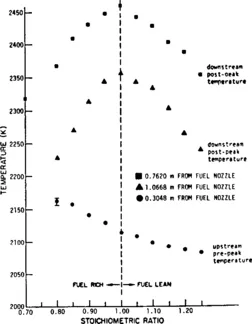![]()
IV
COAL ENERGY
Outline
Chapter 12: ADVANCED OPTICAL TECHNIQUES FOR DIAGNOSTICS, CONTROL AND SAFETY IN FOSSIL ENERGY CONVERSIONS
Chapter 13: AQCS FOR COAL FIRED PLANTS IN THE PEOPLE’S REPUBLIC OF CHINA (PRC)
Chapter 14: THE COAL INDUSTRY AND THE COMPREHENSIVE UTILIZATION OP COAL IN CHINA
Chapter 15: CONCEPTUAL DESIGN OF AN ADVANCED PULVERIZED-COAL POWER PLANT
Chapter 16: ENGINEERING AND COSTING COAL SLURRY PIPELINE FOR ELECTRIC UTILITIES AND PORT DELIVERY
Chapter 17: HEATING AND BURNING CHARACTERISTICS OF SINGLE COAL-WATER SLURRY DROPLET USED AS A NEW FORM OF FUEL
Chapter 18: HIGH SPEED THREE-DIMENSIONAL DIAGNOSTICS IN COMBUSTION
Chapter 19: THE PROSPECTS OF THE APPLICATION OF NEW TECHNIQUES IN THE UTILIZATION OF COAL AND OIL SHALE IN CHINA
Chapter 20: TECHNICAL ADVANCES IN COAL UTILIZATION
![]()
ADVANCED OPTICAL TECHNIQUES FOR DIAGNOSTICS, CONTROL AND SAFETY IN FOSSIL ENERGY CONVERSIONS
David L. Murphree
Director Edward J. Beiting, Project Scientist, Robert E. Stickel, Project Scientist and Rangaswami Arun Kumar, Research Associate, MHD Energy Center, Mississippi State University, Mississippi State, MS 39762
T.K. Lau
Project Manager
,
Office of Coal Utilization & Extraction, Fossil Energy, U.S. Department of Energy ABSTRACT
Microprocessor-controlled, optical diagnostic instrumentation systems are being developed at Mississippi State University for the U.S. Department of Energy’s (DOE) magnetohydrodynamic (MHD) program and other fossil energy technologies. Three of these instrumentation techniques are described. The sensitivity of the temperature gradient of the combustion flame to a change in stoichiometry indicates a possible optical stoichiometric control technique. A microprocessor-controlled, packaged optical instrument for non-intrusive measurement of nitric oxide (NO) concentration in a combustion gas is described. Experimental results are presented using coherent anti-Stokes Raman spectroscopy (CARS) for spatially and temporally resolved temperature measurements in a simulated coal-fired envi ronment.
KEYWORDS
Microprocessor-controlled
optical combustion diagnostics
stoichiometric control
non-intrusive nitric oxide measurement
CARS
INTRODUCTION
On-line or in-situ techniques offer the only means to characterize a combustion process such that basic data can be obtained for modeling of the process. State-of-the-art instrumentation and techniques do not currently have the capability of measurement at process conditions to supply the information needed because of high temperature and pressure requirements.
U.S. Department of Energy (DOE) investigations are being conducted at Mississippi State University into non-intrusive optical techniques for advanced fossil energy processes to determine temporal and spatial resolution of combustion stoichiometry, nitric oxide concentration, molecular composition of gases, and combustion temperature.
This work is being conducted to remove major deficiencies existing in the diagnostics and control of these parameters, which are critical to the success of advanced fossil energy processes such as coal gasification, liquefaction, fluidized-bed combustion, magnetohydrodynamics and oil shale retorting.
OPTICAL STOICHIOMETRIC CONTROL
Experiments performed on the Mississippi State University combustion test stand have shown it is possible to determine the air/fuel stoichiometry in similar oil-fired combustion systems by making fast, relatively accurate measurements of the flame temperature gradient.
The combustion of hydrocarbons can be described in terms of three sequential and macroscopic events (Hautman and colleagues, 1981). The hydrocarbon is first transformed into smaller intermediate hydrocarbon species, then oxidized to carbon monoxide, and finally oxidized to carbon dioxide. The last two steps are the exothermic stages responsible for the release of energy during hydrocarbon oxidation. In the case of fuel-rich combustion a lesser amount of carbon monoxide is completely oxidized to carbon dioxide, and the oxidation of the hydrocarbon fragments to carbon monoxide is the main source of heat. This results in a shorter distance from the fuel injection site to the peak temperature location, compared to cases where a stoichiometric or an excess amount of air is used to burn the fuel. The peak temperature of the fuel-rich mixture is also lower than that obtained with a stoichiometric amount of air. This earlier (and lower) peak temperature for fuel-rich combustion results in lower post-combustion temperatures at downstream locations.
Combustion at the stoichiometric amount or an excess amount of air produces peak temperatures at about the same location, further downstream than the site of the peak temperature for fuel-rich combustion. Air-rich combustion produces a lower peak temperature and lower post-combustion temperatures at downstream locations than combustion with a stoichiometric amount of air.
In summary, fuel-rich flames peak further upstream than air-rich flames and both fuel-rich and air-rich combustion produce lower peak temperatures than combustion using the stoichiometric amount of air. Figure 1 shows gas temperature measurements at three locations on the combustion test stand when burning various quantities of oil (No. 1 diesel fuel oil) with a fixed flow-rate of preheated air. These measurements were made with two microprocessor-controlled, packaged sodium line reversal emission/absorption systems equipped with fiber optics, on the Mississippi State University combustion test stand.
Fig. 1 The effect of stoichiometric ratio (air/fuel) on the gas stream temperature
The lowest curve shows the temperature upstream from the peak temperature location and indicates the early peaking of the gas temperatures for fuel-rich combustion. The upper two bell-shaped curves are for gas temperatures at sites downstream from the peak temperature location. The gas temperatures are lower on the fuel-rich side of the curve because of the early peaking of the gas temperature. The excess air causes the air-rich combustion temperatures to be lower than those obtained with the stoichiometric amount of air.
These tests demonstrate that the combustion stoichiometry can be determined by measuring the gas temperature at two different sites, with one site upstream and one site downstream of the general region where the peak temperature is obtained for all air/fuel ratios. The downstream post-peak temperature will be an indication of how far the stoichiometric ratio is from a value of 1.00. The upstream pre-peak temperature will be an indication that the combustion is either fuel-rich or air-rich. For every air flow-rate there will be a unique set of two gas temperatures that will indicate stoichiomietric ratio.
The key for successfully using this technique is taking fast, accurate temperature measurements. The non-intrusive sodium line reversal instruments developed at Mississippi State University are capable of the precise measurements and f...

